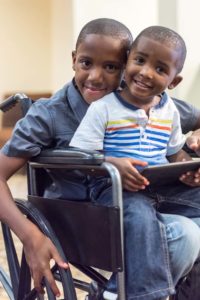The Impacts of Trauma on Children
Traumatic events like difficult medical procedures, bullying, abuse, and neglect can seriously impact children’s physical and mental health, their sense of well-being, and how they interact with others.
When children are afraid and believe that they or someone else is in danger, they may try to physically defend against the danger by fighting back. Or, they may try to flee, or get away from the situation. Sometimes, especially when it is impossible or not safe to fight or get away, children’s response to overwhelming danger can be to physically and emotionally shut down, or freeze. This response is often the only option for infants and children, particularly children with disabilities.
When children experience overwhelming fear and danger over and over, they may begin to experience the same fight, flight, or freeze response during daily interactions with other people or when they are stressed—even long after the danger is passed. If children are not protected by others or cannot protect themselves from danger, they may begin to feel overwhelmed by emotions and fears and expect danger even when they are safe. This is particularly true if they experienced traumatic events frequently, or if the experiences were intense or lasted over long periods of time.
 In general, feeling in danger all the time can make children irritable. It can cause babies to be fussy and cry frequently, and can cause older children to act out anger. As children grow into teenagers and adults, they are at increased risk of harming themselves by abusing cigarettes, alcohol, drugs, sex, and food. They may hurt themselves and take physical risks with their bodies.
In general, feeling in danger all the time can make children irritable. It can cause babies to be fussy and cry frequently, and can cause older children to act out anger. As children grow into teenagers and adults, they are at increased risk of harming themselves by abusing cigarettes, alcohol, drugs, sex, and food. They may hurt themselves and take physical risks with their bodies.
All of these choices can help numb the pain of unresolved trauma. These behaviors are not character flaws, and do not mean that children are “bad” or have mental illness. Instead, these behaviors may be the only coping strategies they have developed to deal with the physical and emotional impacts of trauma, according to the Substance Abuse and Mental Health Administration.
When children are trapped in this pattern, parents and professionals may misunderstand or misdiagnose their behaviors, emotions, and cognitive functioning. Even if the child’s world is currently safe, the child stuck in this traumatized state may continue to experience intense terror, helplessness, hopelessness, and loss of control.
(Above section adapted in part from Levine & Kline, 2007; and James, 1996.)
Symptoms of prolonged trauma can include:
Hyper-arousal
- panic attacks, anxiety, phobias, flashbacks
- exaggerated startle and emotional response
- extreme sensitivity to light and sound
- hyperactivity, restlessness
- nightmares and night terrors
- avoidance behaviors, clinging
- increased risk-taking behaviors
- frequent crying and irritability
- abrupt mood swings (e.g. rage reactions and temper tantrums)
- in young children, regressive behaviors, such as wanting a bottle, wetting the bed, using fewer words
Dissociation
- distractibility and inattentiveness
- amnesia and forgetfulness
- reduced ability to organize and plan
- feelings of isolation and detachment
- muted or diminished emotional responses, making it difficult to bond with others
- easily and frequently stressed out
- excessive shyness, spending time in an imaginary world
Constriction, Freeze, and Immobility
- headaches, stomachaches, asthma
- helplessness, shame, and guilt
- bed-wetting and soiling
- clinginess/regression to younger behaviors
- low energy/fatigues easily
- repetitive play
- diminished curiosity and capacity for pleasure
(Adapted from Levine & Kline, 2007, pp. 75, 77, & 78.)
Children with Intellectual and Developmental Disabilities
 In addition to the previous symptoms, children with intellectual and developmental disabilities who experience traumatic events may lose some of their ability to function in day-to-day life.
In addition to the previous symptoms, children with intellectual and developmental disabilities who experience traumatic events may lose some of their ability to function in day-to-day life.
However, people in the lives of children with disabilities may not recognize these changes in behavior as potential symptoms of trauma. When children with disabilities begin to have temper tantrums, cry more, destroy toys, stop being able to do tasks, or withdraw, adults in their lives may focus on fixing the “problem” behavior.
This approach does not work for children whose behavior changes as a result of trauma. In fact, focusing on changing behaviors without addressing what happened to the child can make the trauma worse, according to the National Child Traumatic Stress Network.
All of these responses in children are normal reactions to the abnormal experience of being hurt, abused, or neglected.
Helping Children with Disabilities Recover and Heal
Children and youth with disabilities can heal and recover from sexual assault, abuse, and neglect. Adults can assist in that healing by making children's environments as safe and stable as possible.
Children who have experienced traumatic events are very often very good at sensing stress and anxiety in other people. Adult stress can increase children’s stress, making it more difficult for them to feel safe. The great news is that the opposite is also true. Adults who are calm can help children feel greater comfort and safety.
When you are trying to support a child who is distressed:
- Repeatedly check in with your own level of calmness/anxiety/stress.
- If you are stressed and anxious yourself, find ways to ground yourself before talking to the child. Take a deep breath and let it out slowly, or do a short meditation exercise.
- Keep in mind how you appear to the child. What are you saying by the way you are sitting or standing? How close or far away you are? Your tone of voice?
- Keep your voice calm and low, and notice how your eye contact, facial expressions, tone of voice, and gestures impact the child.
(Above section adapted from Levine & Kline, 2007; and James, 1996.)
Other tips from SAFE and Substance Abuse and Mental Health Administration (SAMHSA) for helping children recover and heal:
- Be available for children.
- Listen. Accept what they share, and let them know that whatever feelings they have are okay. Common reactions are feeling sad, anxious, scared, and angry.
- Let children know that you care about them.
- Focus on the child’s strengths.
- Understand that the child is coping as best they can.
- Know that children can recover and heal.
- Remind the child that what happened was not their fault.
- Keep to your standard routines. Parents and educators sometimes worry about making the child who experienced abuse suffer more, and may stop setting limits or keeping schedules. However, it can make children feel more secure if they do the same things they always have.
Practicing Grounding
 Adults who are feeling high amounts of stress and anxiety can practice “grounding” themselves for relief.
Adults who are feeling high amounts of stress and anxiety can practice “grounding” themselves for relief.
To be grounded is to be present instead of being intensely focused on fears about the future or regrets about the past. When grounded, you are more likely to feel safe and face life moment by moment instead of avoiding painful thoughts or feelings.
Here are a few examples of what you can do to help become more grounded in the present moment: get moving, dance, jog, ride a bike, walk, swim, just be physically active; walk barefoot on the grass or sand; meditate; think about where your feet are touching the ground; take a hot bath or shower; sit outside and look around—see what you are noticing, hearing and smelling.
Brief Exercise
Bring your focus to your body and your present experience.
Notice your:
- FEET (on the ground…)
- BACK (against the back of the chair…)
- HANDS (wherever they might be resting…)
- SEAT (on the chair…)
Check your breath…take a few deep breaths.
Take some time to look around. Find something pleasing to look at to orient you to the present and increase your sense of safety in the moment.
(Kline & Downing, 2012, as cited in Mastroleo & Schwartz, 2013.)
Resources on Healing
- Healing and Support for Children and Parents Stop It Now!
- Coping with the Shock of Intrafamilial Sexual Abuse National Child Traumatic Stress Network
- Child Sexual Abuse: Coping with the Emotional Stress of the Legal System Information for Parents and Caregivers. National Child Traumatic Stress Network
- National Child Traumatic Stress Network This website provides a number of resources for parents, educators, and other service professionals to better understand and respond to children who have experienced trauma, including children with disabilities.
- Trauma-Proofing Your Kids: A Parents' Guide for Instilling Confidence, Joy and Resilience Book by Maggie Kline & Peter A. Levine.

